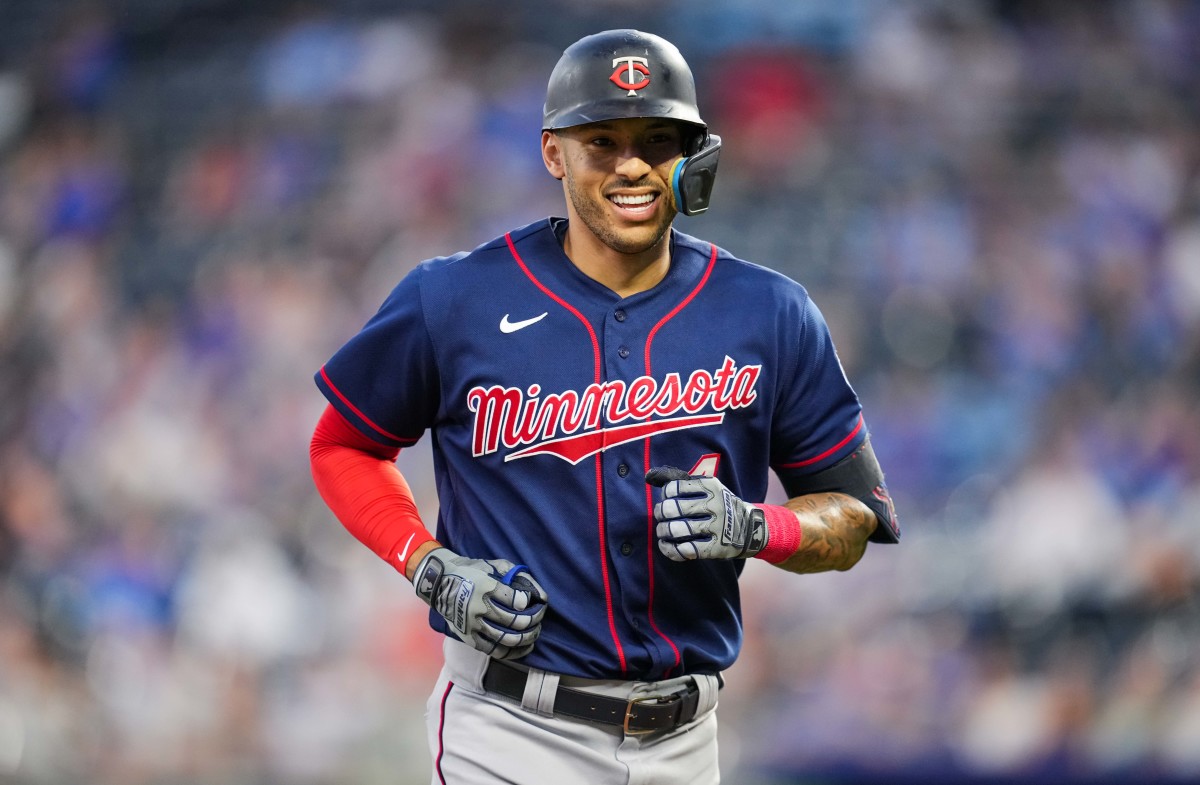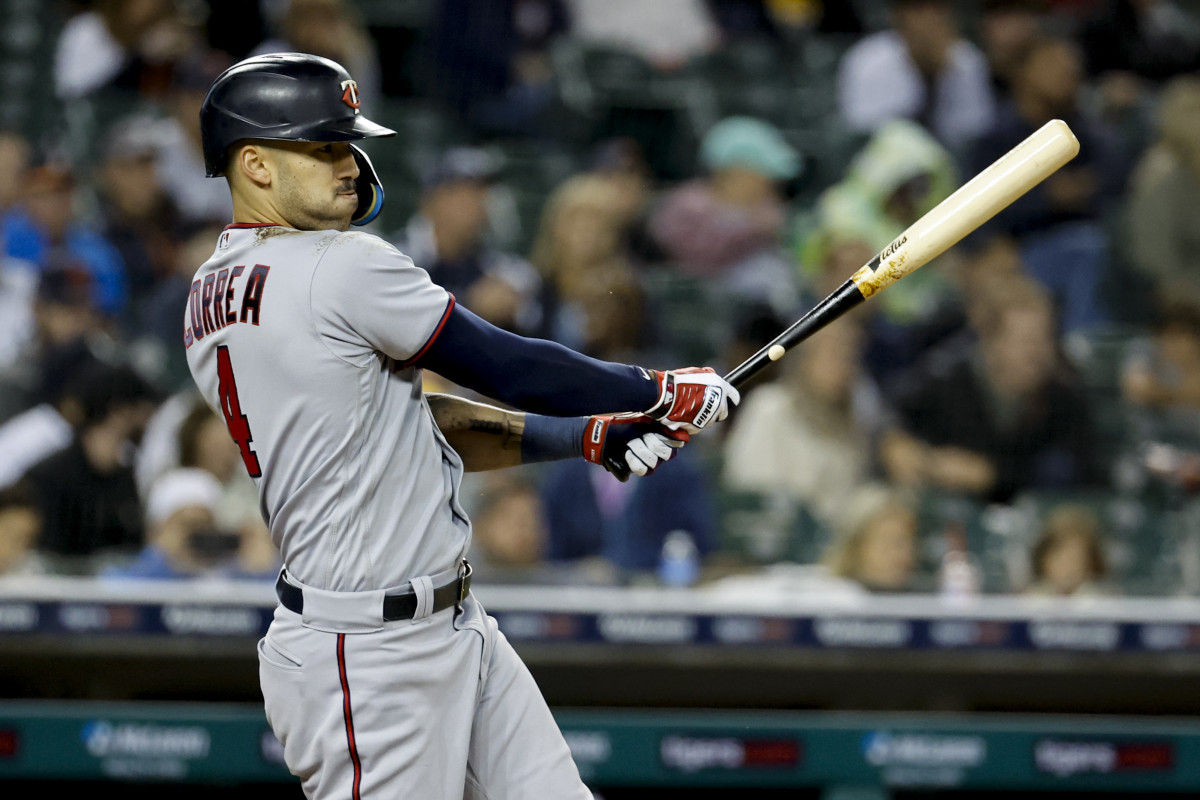SF Giants free-agent breakdown: Minnesota Twins SS Carlos Correa

It’s big money season.
That’s what Twins’ shortstop Carlos Correa was counting on when he signed a 3-year, $105 million contract to Minnesota that became essentially a one-year deal when he exercised his player opt-out clause. Now, Correa finds himself at the center of another loaded free agent shortstop class, looking for a bounty in a big game hunt once more. And that's where the SF Giants might come in.

Correa, entering his age 28 season, is making top-of-the-market money in his current contract. But even if he plays it out with a couple more good seasons, any subsequent contract would be that much shorter. It makes sense for him to plant his flag now and figure out where he’ll be playing for the rest of the career. San Francisco just so happens to be the perfect place for him to call home.
In an ideal world, the Giants sign Correa to a long-term contract, trade Marco Luciano and Brandon Crawford to the Angels as part of a package for Shohei Ohtani, and lure Aaron Judge away from New York while they’re at it. Such a clean sweep is, unfortunately, unlikely. But there are a lot of reasons why, from a talent standpoint, Correa would be an immediate upgrade for the Giants.
The thing that jumps out the most is that Correa crushes the ball. He’s routinely in the top 5% of the league in max exit velocity, and his Statcast page is filled with a LOT of red (unlike tax sheets and grade school papers, this is a good thing) in categories like expected slugging and barrel percentage. That’s a must for any free-agent hitter coming to Oracle Park, even if the Giants have done their best to shed its perception as a pitcher’s ballpark in the last couple of years.
Correa’s also been a great defender over his career. From 2018 through 2021, Correa ranked in the top 3% of defenders according to Outs Above Average. For a team whose defensive deficiencies wreaked so much havoc on their playoff hopes, bringing in a plus defender on the infield is pretty much essential for the type of contract Correa’s looking for. He’s also younger than Trea Turner, Xander Bogaerts, and Dansby Swanson, which makes the back end of his contract a little easier to swallow.
On top of all that, Correa has drawn effusive praise from teammates wherever he’s gone. The trash can scandal that plagued the Astros’ 2017 run has followed Correa, even into Minnesota five years later (mostly from the occasional disdainful fan). But he’s one of the few players who’s taken responsibility for his actions. It takes a lot of guts to say, “We cheated, I regret it, and I’m going to make sure it never happens again in my clubhouse.” And that willingness to take responsibility has helped him remain an impactful voice in the dugout and on the field. If there’s anyone that can thrive in San Francisco’s collaborative clubhouse after that scandal, it’s Correa.
Still, like any massive free-agent contract, there are reasons for the Giants to be cautious. That starts with his concerning injury history. Correa has missed 9, 53, 52, 87, 2, 14, and 26 games in his 7 full seasons, those numbers starting in 2016 and going through 2022. It’s notable that even in his most injured season, Correa still tallied 3.7 WAR, which is probably the best case for Crawford next year. But how well he ages through the course of that contract will be a cause of concern - as it is for any older player - for a few reasons.

Some of Correa’s advanced numbers show that he can be streaky at the plate - really streaky. In 2017, Correa posted a .315 batting average and a .941 OPS during his 6.7 WAR All-Star campaign. The next year, when he was beset by injuries, his slash line fell all the way to .239/.323/.405, his OPS dropping over 200 points. But the issue isn’t so much that he’s capable of having an average offensive season, which of course most baseball players will run into at some point. The red flag here is a precipitous drop in his defense.
Correa found himself recording an unusually bad defensive season in 2017, ranking in the bottom quartile of the league according to Outs Above Average. It turned out to be a mere hiccup, as Correa would put up the spectacular numbers mentioned previously, becoming a premium defender at the shortstop position. For some reason, though, his defense took a nosedive in 2022, dropping all the way back to the bottom 20%. His arm strength has taken a bit of a hit, and worryingly, Correa’s speed grade has steadily declined from a sizzling 84 in his debut season to a pedestrian 45 last year.
All of this portends an important question; is there something about Correa’s game that’s irreparably declining? He’s gotten slower and slower every year and seems strangely prone to falling off in random areas. This problem might be stochastic in nature - when he deals with major injury or unusual circumstances, he loses his edge, as might be expected. If that’s the case, then, the question is how often the Giants would have to deal with such volatile performances. They’ve already shown that they can extract tremendous value out of veterans, so ideally there’s some sort of plan in place to ensure that Correa remains a defensive asset for years to come. But if he’s liable to give that defensive value back every other year, the Giants would have to contend with a 2-win player on a 6-win contract.
Still, it’s possible these concerns are overplayed. Most players struggle with the transition of playing for a new team, and this adjustment period could explain Correa’s defensive drop-off in Minnesota. Plus, Crawford’s hasn’t been in the top half of sprint speed since 2015, yet he’s been in the top 10% of the league by Outs Above Average in that time. Weirdly enough, this makes Correa project to be some kind of wild double-Brandon hybrid, with the powerful yet streaky ceiling of Belt’s presence at the plate and Crawford’s continually excellent defense. I’m in favor of signing the FrankenBrandon, but your mileage may vary.
Correa’s a bit more complicated than the other top-of-the-market free agents because he doesn’t have an unquestionably elite skill that projects itself confidently over the next 8-10 years. He’s not on a Hall-of-Fame trajectory, but he’s still a great player in his prime. If his market is for 8 years at $260 million ($32.5 mil. AAV), he’d be a steal for San Francisco. If he’s looking for 10 years at that same rate, the conversation gets a lot tougher.
There is also one more nagging consideration. I still don’t actually know what signing Correa would do with Crawford, which makes San Francisco’s incumbent shortstop an underrated component to this puzzle. Asking Correa to move to second or third while Crawford’s active might be awkward, but maybe it turns the infield into a defensive powerhouse next year. Maybe the Giants pull the trigger on that Ohtani trade, and this problem is completely moot. But the Giants sure can’t cut Crawford, replace him with Correa, and call it a day. That won’t be good enough after a disheartening 2021 season.
So, think of Correa like an elephant gun. He’s going to be absolutely dangerous no matter where he ends up. But if the Giants want to juggle his contract along with all their other offseason moves, they’ll need to know exactly what they’re doing. Shooting themselves in the foot here won’t be something they can laugh off. But now, more than ever, this is the Giants’ offseason to get creative. Up the AAV a bit. Add a team-friendly 9th-year club option to recoup some potential value once Carlos Correa’s a grizzled DH and buy him a penthouse in Mission Rock. Set the target straight, and the SF Giants just might snag themselves a prize.
